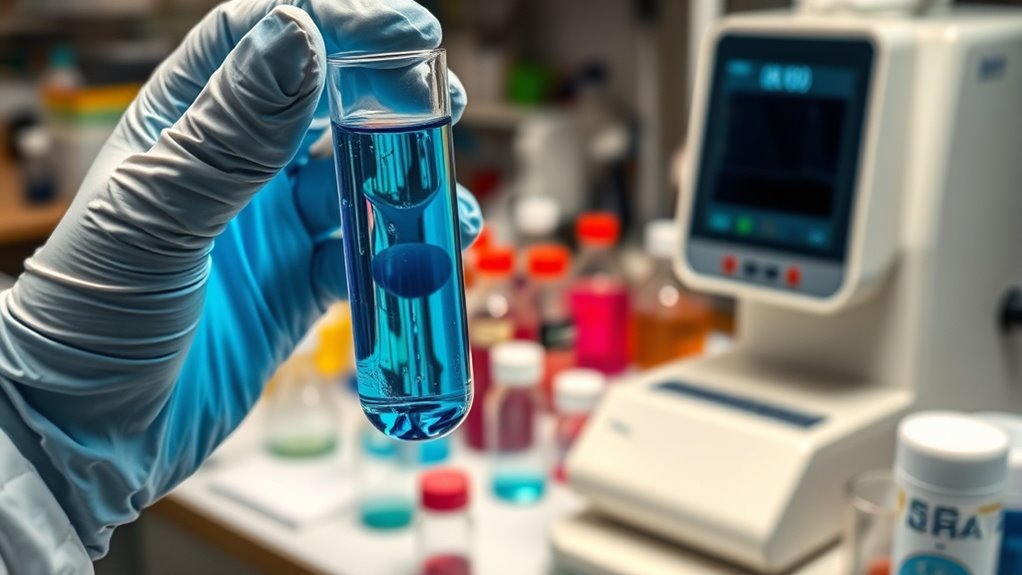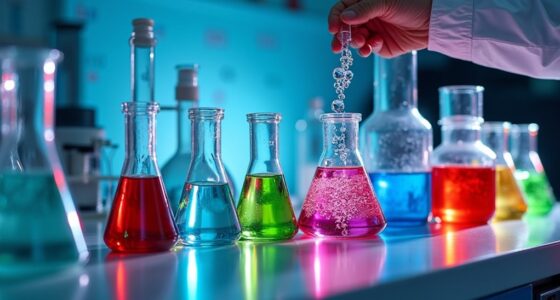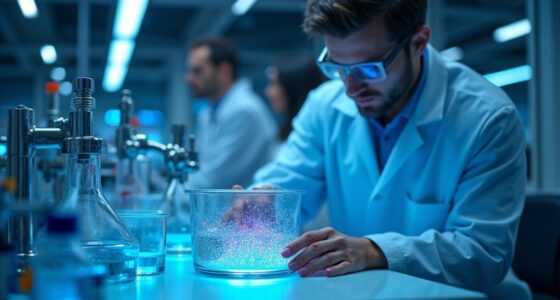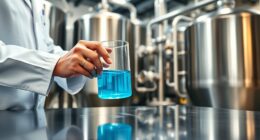To identify unknown substances, chemists use a combination of physical property tests like melting points and solubility, along with chemical reactions to observe functional groups. They then analyze samples with spectroscopic techniques such as IR, NMR, and UV, combined with mass spectrometry and chromatography for detailed molecular information. Advanced methods like X-ray diffraction reveal crystal structures. If you keep exploring, you’ll discover more about how these techniques work together for precise identification.
Key Takeaways
- Chemists analyze physical properties like melting point, boiling point, and refractive index to gather initial identification clues.
- They perform chemical tests such as solubility, acid/base reactions, and reagent tests to identify functional groups.
- Spectroscopic techniques like IR, NMR, UV, and Raman provide detailed molecular structural information.
- Chromatography and mass spectrometry separate and determine molecular weight, aiding in compound identification.
- Structural analysis using X-ray diffraction and advanced computational tools confirms the substance’s molecular arrangement.
Utilizing Physical Property Tests
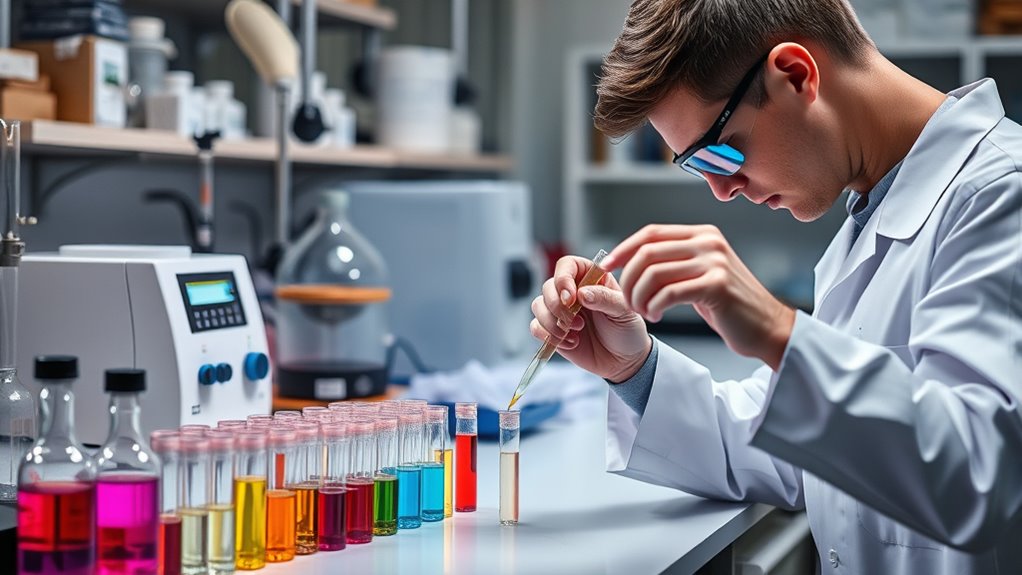
Utilizing physical property tests is a fundamental step in identifying unknown substances because these tests rely on observable and measurable characteristics that do not change the substance’s chemical identity. Optical properties, such as refractive index and optical activity, provide valuable clues about a substance’s structure and purity. Measuring phase transitions, like melting and boiling points, helps determine the material’s state and purity level; narrow ranges indicate high purity. Observing how the substance shifts between solid, liquid, or gas under standard conditions reveals phase behavior. These tests are non-reactive, meaning they don’t alter the substance. By analyzing optical properties and phase transitions, you gain reliable, initial insights into the material’s identity, making them essential tools for chemists in the identification process. Additionally, understanding the trustworthiness of AI models can help chemists interpret data more accurately and recognize potential biases or vulnerabilities in analytical tools. Incorporating knowledge of survivalism tools, such as portable water purification systems, can also provide context when identifying substances relevant to field or emergency situations. Recognizing the importance of proper calibration ensures the accuracy of measurements taken during physical property testing. Furthermore, employing standardized testing procedures enhances the reproducibility and consistency of results across different laboratories. Moreover, staying informed about industry transformations, like advancements in AI automation, can improve the efficiency and accuracy of analytical methods used in substance identification.
Applying Chemical and Functional Group Tests
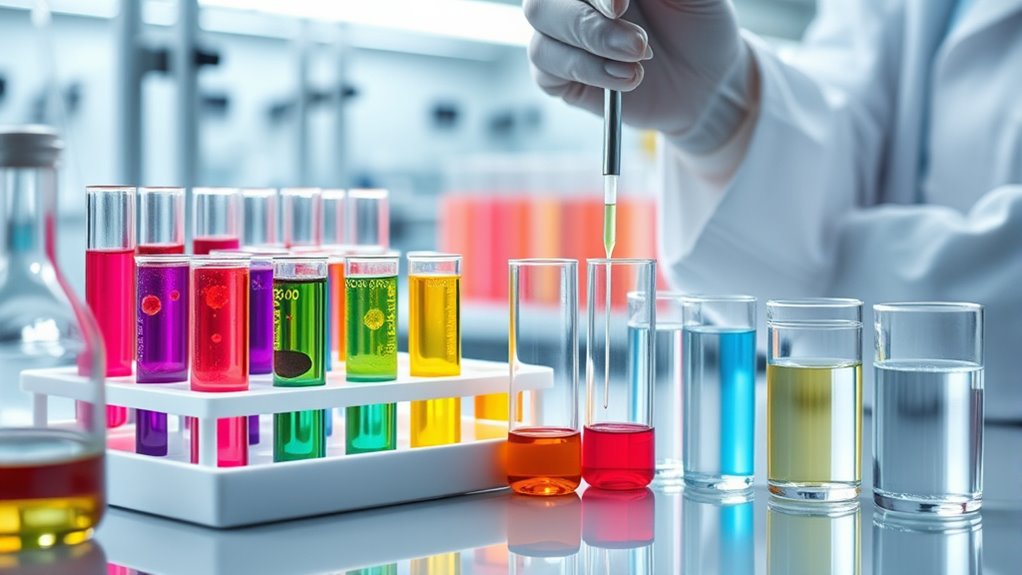
Applying chemical and functional group tests allows you to quickly identify key features of an unknown substance. These tests include solubility behavior, acid/base reactions, and reactions with specific reagents, revealing functional groups like phenols, aldehydes, or amines. Bromine water and KMnO₄ oxidation help confirm the presence of double bonds or unsaturation. For more precise identification, spectroscopic analysis offers detailed molecular information, while chromatographic methods separate compounds based on polarity or volatility. Tests such as ferric chloride or Tollens’ reagent provide quick visual confirmation of specific groups. Combining these chemical tests with instrumental techniques enhances accuracy, allowing you to classify the substance’s structure and functional groups efficiently. This integrated approach streamlines the identification process of unknown compounds. The use of these tests is based on understanding the chemical properties and reactions characteristic of different functional groups.
Leveraging Spectroscopic Techniques
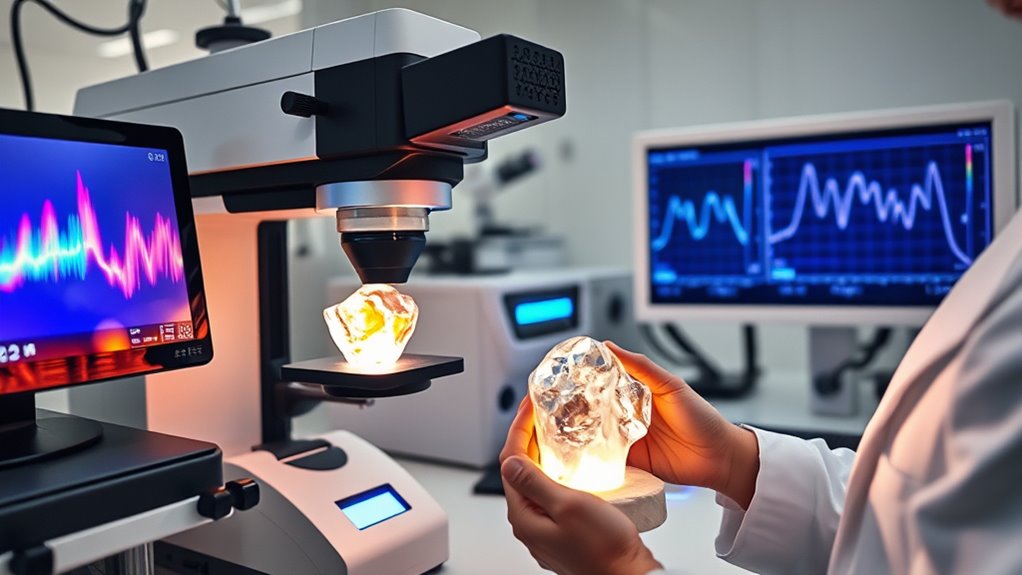
Spectroscopic techniques are essential tools for chemists seeking to identify unknown substances, as they provide detailed molecular information that complements traditional chemical tests. By leveraging spectroscopic synergy, you can combine methods like IR, NMR, Raman, and UV to gain a holistic understanding of a compound’s structure and functional groups. IR spectroscopy quickly reveals the presence of specific functional groups through characteristic peaks, while NMR offers detailed insights into atomic arrangements. Raman spectroscopy adds another layer of molecular vibration data, especially useful for solids and powders, and UV spectroscopy helps identify conjugated systems and chromophores. Through analytical integration, combining these techniques enhances accuracy and confidence in identification, allowing you to build a complete molecular profile efficiently and effectively. Spectroscopic techniques are often used in conjunction with other analytical methods to confirm findings and reduce uncertainties. Recognizing the importance of analytical techniques in modern chemistry further underscores the value of using multiple methods simultaneously to achieve precise results.
Employing Mass Spectrometry and Chromatography
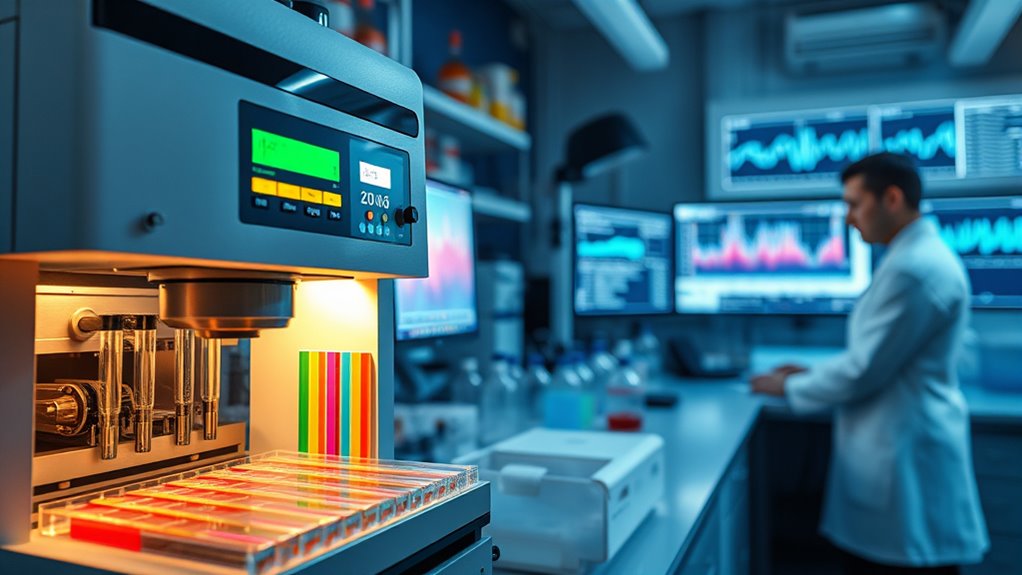
Mass spectrometry and chromatography work together to identify unknown substances by separating complex mixtures and analyzing their molecular components. Chromatography separation isolates individual compounds, providing retention times and peaks that help narrow down possibilities. Once separated, mass spectrometry analysis measures the molecular weight and structure of each component with high resolution, often using techniques like GC-MS or LC-MS. Combining ion mobility spectrometry with mass spectrometry enhances your ability to distinguish similar molecules in complex biological or forensic samples. You can compare observed spectra against extensive databases or use advanced algorithms like EASI for identification. Recent advances in high-resolution ion mobility spectrometry-mass spectrometry (HR-IMS-MS) provide even more detailed data, allowing for faster and more accurate identification of unknown compounds. This integrated approach allows you to detect trace substances, determine molecular formulas, and confidently identify unknown compounds quickly and accurately. Additionally, encryption techniques can be employed to securely store and transmit sensitive data related to analytical results, ensuring data integrity and confidentiality throughout the identification process. Incorporating data analysis software further streamlines the process by automating pattern recognition and reducing manual interpretation errors, and utilizing spectral databases can improve the accuracy of compound identification. Moreover, advancements in automation technologies have reduced analysis time and increased throughput in analytical laboratories.
Conducting Gravimetric and Titration Analyses
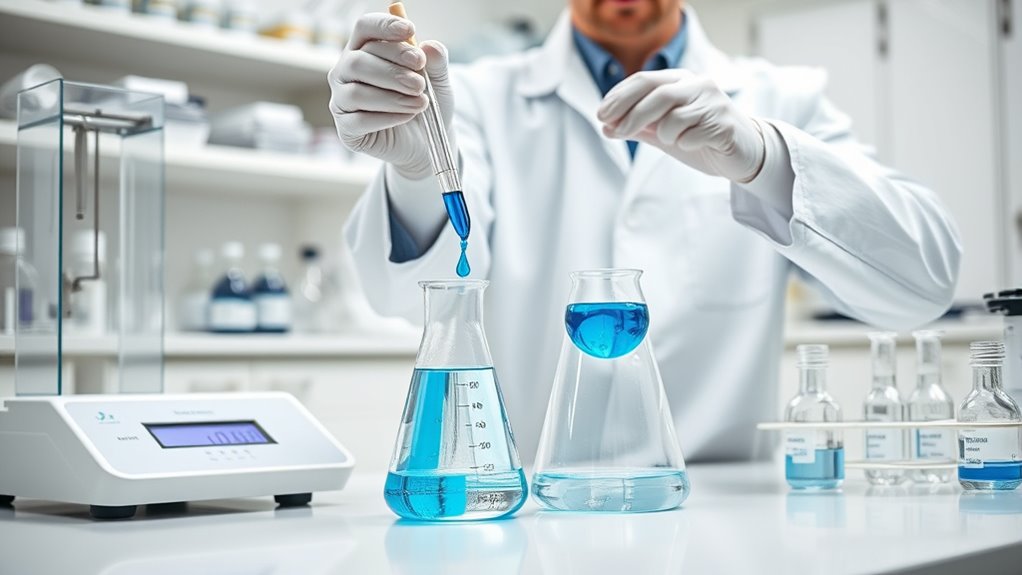
Conducting gravimetric and titration analyses allows you to determine the composition of unknown substances with high accuracy. You begin with careful sample preparation, making certain the sample is weighed precisely and dissolved properly. Reagent selection is critical; choose chemicals that react specifically with the analyte to produce measurable results. In gravimetric analysis, you precipitate the desired ions, filter, dry, and weigh the solid to find its mass, which reveals the sample’s composition. Titration involves adding a known reagent until the reaction reaches its endpoint, indicated by a visual cue. Combining both methods provides a thorough understanding of an unknown substance, with gravimetric analysis offering solid measurements and titration confirming concentrations. Proper technique in sample prep and reagent choice guarantees reliable, precise results. Using accurate measurement techniques ensures the validity of the analysis and minimizes errors in the final results.
Determining Crystal Structures With X-Ray Diffraction
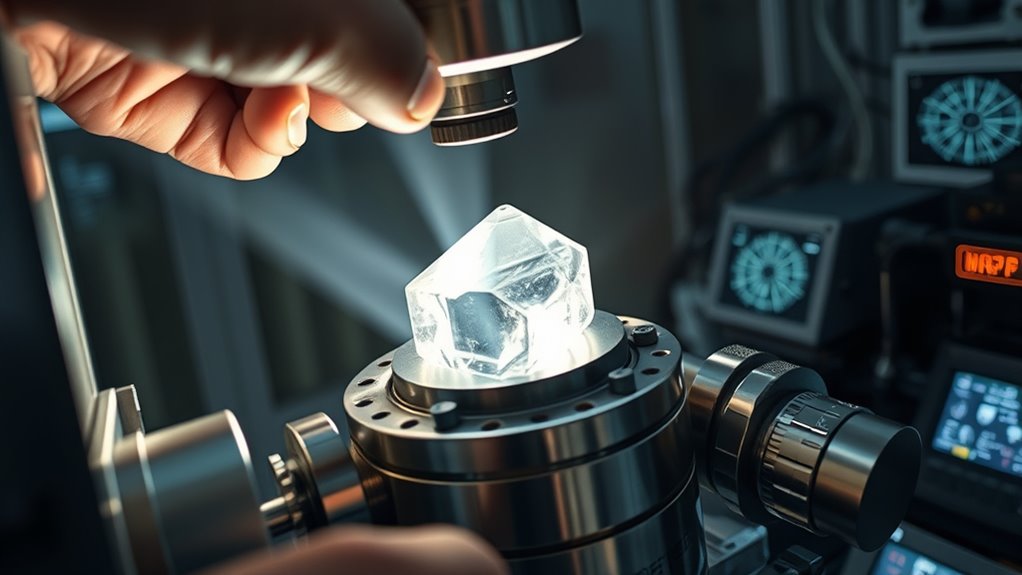
Determining the crystal structure of a substance using X-ray diffraction provides detailed insights into its atomic arrangement. You start with a high-quality, defect-free crystal to obtain clear diffraction patterns. When X-rays hit the crystal planes, they reflect at specific angles satisfying Bragg’s Law, creating distinctive diffraction spots. These diffraction patterns reveal the crystal symmetry, which is categorized into seven crystal systems based on unit cell dimensions and angles. By analyzing the pattern, you assign Miller indices to each reflection, helping to identify the atomic planes. Advanced software processes the data, solves the phase problem, and refines the atomic positions. This detailed structural information helps chemists understand molecular geometry, polymorphism, and material properties, making X-ray diffraction a crucial tool for identifying unknown substances. The diffraction pattern’s analysis also involves interpreting the interference of scattered waves, which directly reflects the atomic arrangement and symmetry within the crystal.
Implementing Environmental Screening Methods
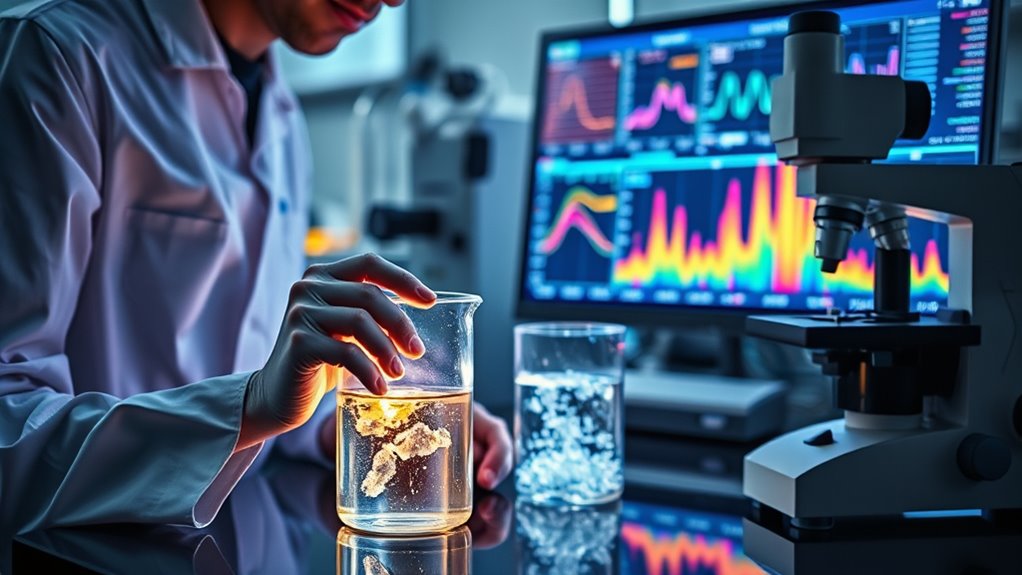
How can you effectively implement environmental screening methods to identify unknown contaminants? Start by utilizing remote sensing techniques to gather broad data on pollution patterns across large areas, highlighting potential hotspots. Combine this with bioassay techniques, which assess biological responses to samples, providing early indications of toxicity and contamination. Portable tools, like immunoassays, allow quick pre-screening of samples for high-risk substances. Use spectral libraries and retention time data to narrow down candidates, prioritizing those with environmental persistence or toxicity. Software tools help manage complex HRMS data, reducing false positives and streamlining identification. This integrated approach enables rapid, targeted investigation of unknown pollutants, facilitating early intervention and more accurate environmental monitoring without relying solely on standard laboratory methods. Additionally, understanding the contrast ratio of detection methods can improve the clarity of results, ensuring more precise identification of contaminants.
Combining Multiple Techniques for Accurate Identification

Combining multiple analytical techniques enhances the accuracy of identifying unknown substances by leveraging their complementary strengths. Spectral libraries, like NIST, automate matching spectra with algorithms, speeding up identification. Machine learning models trained on these databases further improve prediction accuracy, handling complex data patterns efficiently. Using techniques such as UV-Vis, IR, Raman, and NMR provides a thorough molecular profile, while chromatography coupled with mass spectrometry offers separation and detailed fingerprinting. Cross-validating results from orthogonal methods, like FTIR and Raman, confirms molecular structures. Spectral libraries facilitate rapid comparisons and reduce manual interpretation errors. By integrating spectral matches, multivariate analysis, and pattern recognition, you minimize errors and increase confidence in your identification. This multi-technique approach ensures more reliable, precise results, especially when corroborated by spectral libraries and machine learning, making the process faster and more accurate. Additionally, establishing a clear analytical strategy upfront significantly reduces time and costs during the identification process.
Frequently Asked Questions
How Do Chemists Confirm the Purity of an Unknown Substance?
You confirm the purity of an unknown substance by combining spectroscopic techniques and chromatographic methods. Spectroscopy, like UV-Vis or FT-IR, helps identify functional groups and assess purity through characteristic absorption patterns. Chromatography, such as HPLC or GC, separates components to detect impurities and determine purity levels. Using these orthogonal methods together provides a thorough validation of the substance’s purity, ensuring accurate, reliable results.
What Role Do Computational Tools Play in Substance Identification?
Did you know that over 80% of substance identification now involves computational tools? You can use spectroscopic techniques combined with molecular modeling to analyze and predict chemical structures efficiently. These tools help narrow down possibilities, interpret complex data, and visualize molecules in 3D. With computational methods, you gain faster, more accurate insights, making it easier to identify unknown substances and understand their properties in a streamlined, effective way.
How Are Novel or Synthetic Compounds Identified?
When identifying novel or synthetic compounds, you rely on spectroscopic techniques like NMR, IR, and Raman to determine molecular structure and functional groups. Chromatographic methods help separate components and analyze retention times for purity and composition. By combining these techniques, you can characterize unknown substances accurately, pinpoint their unique features, and confirm their identities, ensuring you understand their chemical makeup and potential applications.
Can Non-Destructive Methods Be Used for Substance Analysis?
You can use non-destructive methods for substance analysis, primarily through spectroscopic techniques that provide chemical fingerprinting without damaging samples. These methods, like Raman spectroscopy or XRF, let you identify and characterize materials accurately while preserving their integrity. This approach is efficient, cost-effective, and ideal for analyzing valuable or limited samples, giving you detailed insights into chemical composition and structure without the need for destructive testing.
How Do Chemists Differentiate Isomers of the Same Molecular Formula?
Did you know that chemists often use multiple methods to differentiate isomers? To tell them apart, you rely on spectroscopic techniques like IR and MS, which reveal structural differences, and chromatographic methods like HPLC, which separate isomers based on their interactions. Combining these approaches provides a detailed picture of each isomer’s unique properties, making it easier to identify and distinguish compounds with the same molecular formula.
Conclusion
By combining physical, chemical, and spectroscopic techniques, you can accurately identify unknown substances. Many chemists believe that no single method is foolproof, so they verify results through multiple tests. Investigating this approach confirms that using a combination of methods increases reliability, much like cross-checking facts in research. Ultimately, thorough analysis guarantees you understand a substance’s true nature, proving that careful, multi-faceted testing is essential for accurate identification.
